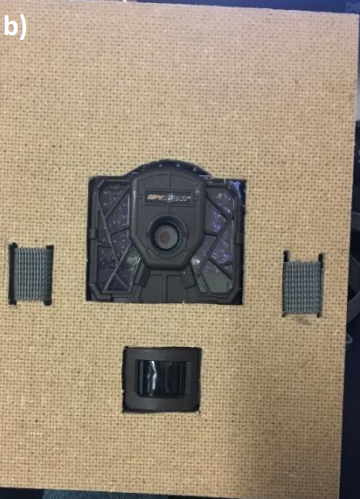
Nesting kestrels provide insight into how birds respond to climate change, but their nests can be difficult to observe because kestrels lay eggs inside tree cavities. Fortunately, researchers can post nest boxes with trail cameras to capture activities. When a local research team noticed that the platforms used to hold cameras in kestrel boxes during nesting season were warping and weathering, they turned to the Albertsons Library MakerLab for help.
“Although these platforms were effective in nest boxes in some climates, we noticed that in humid climates, such as North Carolina and Florida, or very arid climates, such as in New Mexico, that both the nest boxes and the platforms started to warp, so the platforms no longer fit snugly in the nest box,” explained Jason Winiarski, an ecology, evolution and behavior doctoral student with Boise State’s Full Cycle Phenology Project.
The project, led by Boise State University, is in collaboration with American Kestrel Partnership, HawkWatch International, St. Mary’s University, Environmental Laboratory of the U.S. Army Engineer Research and Development Center, and Colorado State University.

Its mission is to monitor the timing of life cycle events, such as breeding and migrating, in American Kestrels to study how they adapt to climate change. To collect data on this large scale, they partner with 13 Department of Defense sites across the U.S. to monitor more than 250 nest boxes, where they collect data on important life cycle events like egg laying, hatching and fledging.
“We use trail cameras placed inside the top compartment of nest boxes to peek in on the birds activities and collect extensive photo data,” said Anjolene Hunt, the research manager for the Full Cycle Phenology project. “Many of these cameras have cellular capabilities, so we can remotely monitor what’s happening at our sites across the country.”

With the equipment that holds the trail cameras in place at risk of warping, researchers had to worry about cameras falling and potentially injuring birds. That’s where Boise State undergraduate students Bailey Myers and Emma Casselman stepped in. Boise State employs several undergraduate work study students on the phenology project, as well as graduate students.
“It’s been a really great experience for me,” Myers said. The chemistry major currently works as a research technician for the project.
Myers and Casselman work locally with Hunt, Winiarski and Ashley Santiago, a field technician on the Full Cycle Phenology Project. They approached the MakerLab with the idea of 3D printing more durable camera holders.
“We had previously worked with the MakerLab to create a container to place birds in to avoid stress or injury while weighing the birds and taking other measurements,” Santiago said. “We were very happy with the durability of these containers, and decided to try a similar approach when we needed new camera platforms.”
The cost of printing the equipment was comparable to buying tempered hardwood and then cutting it to size, the team said. The team began replacing the equipment in December 2019. As of April 2020, project partners have installed 3D printed platforms in nest boxes in California, Texas, Florida and North Carolina.
“As a bonus, the amount of hours saved from 3D printing using a template, saved us time and cost that we would have used to cut the hardboards,” Santiago said. “Plus our undergraduate students were able to gain valuable knowledge on how to use 3D printing equipment.”
“We are so grateful to the MakerLab team and our team of technicians and undergraduates who have put in the time and effort to make these 3D printed platforms,” Hunt said.